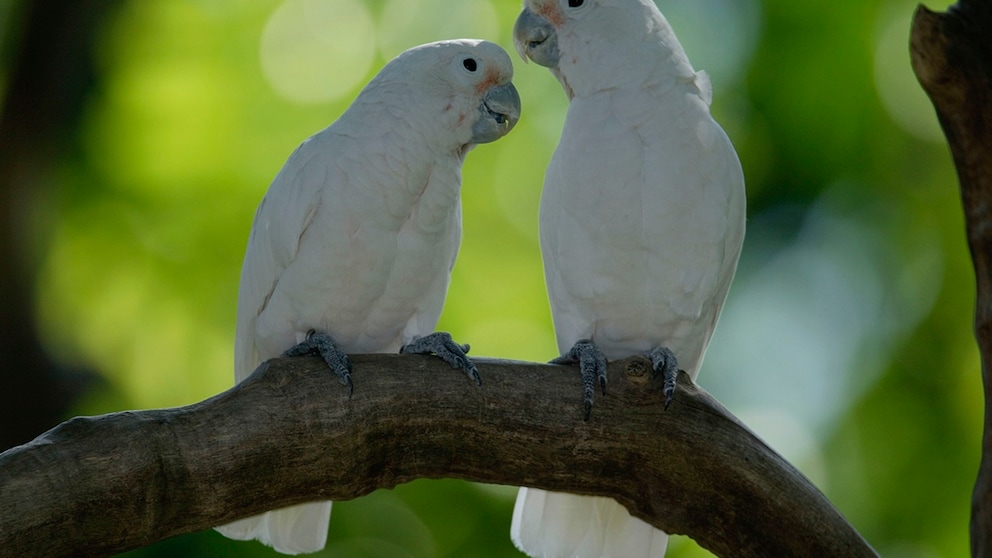February 15, 2025, 4:25 pm | Read time: 3 minutes
Seasoning fries with ketchup or mayonnaise is completely normal for humans. In the animal kingdom, on the other hand, seasoning food is less common and has so far only been documented in primates. However, apparently, cockatoos would also opt for a “seasoned” dish, as one study describes, namely pasta with blueberry yogurt.
We already knew that certain birds make their food more palatable. Crows and magpies, in particular, have been observed to soften hard pieces of bread in water to make them easier to eat. However, actively “seasoning” their food was previously only known from some primates, which often spice up leaves and fruit with crushed insects, especially ants. But the Goffin’s cockatoo also seems to prefer a rather strange flavor. A study shows that cockatoos particularly like pasta with vegan blueberry yogurt.
Half of Cockatoos Like to Dip Pasta in Blueberry Yoghurt
The study, conducted at the Goffin Lab in Austria, examined the behavior of a group of 18 cockatoos. Nine of them showed the novel “seasoning behavior” by dipping pasta and potatoes in blueberry soy yogurt instead of just eating it. But does this really serve to improve the taste? Or, were the birds only interested in the consistency or color of the yogurt?
We investigated whether they liked to dip certain foods, whether they preferred a certain type of yogurt, and whether color or texture made a difference in their choice of “dip.” Breakfast observations (30 minutes each) were carried out over a period of 14 days. The birds were offered three possible “sauces”:
- Fresh water
- Blueberry soy yogurt
- Neutral soy yogurt
Tests were also carried out to disprove alternative explanations, such as color preference. The birds were offered cubes of similar color but with a neutral taste. Finally, the researchers used statistical models to analyze how often and under what conditions the birds dipped their food into the different media.
Cockatoos Showed a Clear Preference for Blueberry Yogurt
The results clearly show that the cockatoos used blueberry yogurt specifically to enhance their taste. Of the 18 birds, 9 dipped their food in soy yogurt – preferring blueberry yogurt to the neutral variant.
- None of the birds dipped their food in water – thus ruling out the hypothesis that the behavior was simply to change the texture.
- Certain foods were preferentially dipped: pasta more frequently than potatoes.
- Blueberry yogurt was preferred by the cockatoos over neutral yogurt.
- The behavior could not be explained by a color preference, as the cockatoos showed no clear preference in the color test.
- The cockatoos ate yogurt and dipped food together without licking the yogurt first – a further indication that they preferred the combination of both.
These discoveries raise exciting questions about the cockatoos’ cognitive abilities and possible parallels with human eating habits. For a very long time, refining food with flavors was considered an exclusively human behavior.

Study reveals Why cats can’t help themselves when it comes to canned tuna

Surprising Conditioning Dogs in India Prefer the Color Yellow to Food

Deliberate deception Can animals lie? A behavioral biologist gives answers
Phenomenon Requires Further Research
This study provides the first experimental evidence for innovative taste refinement by animals other than primates. The cockatoos showed a conscious preference for a particular flavor and actively combined foods to improve their taste.
The result underlines the birds’ remarkable cognitive flexibility. The ability to deliberately change taste could be an evolutionary adaptation: In the wild, it could help cockatoos to identify more nutritious or better-tasting foods.
The study also shows that innovative feeding strategies are not always adopted by the entire group. Only half of the birds showed the behavior – this may also indicate an individual willingness to experiment. However, the study was carried out on captive animals, and the sample size of 18 animals was not particularly large.
This behavior underlines the cognitive abilities of cockatoos and could be an evolutionary adaptation to changing food sources. Future research could investigate whether such behaviors also occur in the wild and whether they spread within the group.1

